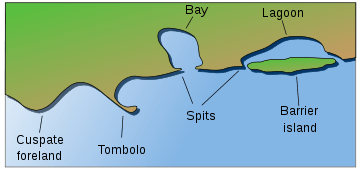Tombolo
A tombolo, from the Italian tombolo, derived from the Latin tumulus, meaning 'mound', and sometimes translated as ayre, is a deposition landform in which an island is attached to the mainland by a narrow piece of land such as a spit or bar. Once attached, the island is then known as a tied island. Several islands tied together by bars which rise above the water level are called a tombolo cluster.[1] Two or more tombolos may form an enclosure (called a lagoon) that can eventually fill with sediment.
Formation



The shoreline moves toward the island (or detached breakwater) due to accretion of sand in the lee of the island where wave energy and longshore drift are reduced and therefore deposition of sand occurs.
Wave diffraction & refraction
True tombolos are formed by wave refraction and diffraction. As waves near an island, they are slowed by the shallow water surrounding it. These waves then bend around the island to the opposite side as they approach. The wave pattern created by this water movement causes a convergence of longshore drift on the opposite side of the island. The beach sediments that are moving by lateral transport on the lee side of the island will accumulate there, conforming to the shape of the wave pattern. In other words, the waves sweep sediment together from both sides. Eventually, when enough sediment has built up, the beach shoreline, known as a spit, will connect with an island and form a tombolo.[2]
Unidirectional longshore drift
In the case of longshore drift from one single or a dominant direction, like at Chesil Beach or Spurn Head, the flow of material is along the coast in a movement which is not determined by the now tied island, such as Portland, which it has reached. In this and similar cases, while the strip of beach material connected to the island may be technically called a tombolo because it links the island to the land, it is better thought of in terms of its formation – as a spit or otherwise.
Morphology and sediment distribution
Tombolos are more prone to natural fluctuations of profile and area as a result of tidal and weather events than a normal beach is. Because of this susceptibility to weathering, tombolos are sometimes made more sturdy through the construction of roads or parking lots. The sediments that make up a tombolo are coarser towards the bottom and finer towards the surface. It is easy to see this pattern when the waves are destructive and wash away finer grained material at the top, revealing coarser sands and cobbles as the base. Sea level rise may also contribute to accretion, as material is pushed up with rising sea levels. This is the case with Chesil Beach (which connects the Isle of Portland to Dorset in England), notable because the shingle ridge is parallel rather than perpendicular to the coast.
Tombolos demonstrate the sensitivity of shorelines. A small piece of land, such as an island, can change the way that waves move, leading to different deposition of sediments.
List of notable tombolos
- The Angel Road of Shodo Island, Japan
- Sanshiro-jima, Dogashima, Nishiizu, Japan
- Aupouri Peninsula, New Zealand
- Ayre o Swinister, Shetland Islands, Scotland
- Barrenjoey Headland, Pittwater, New South Wales, Australia
- Beavertail Point, Conanicut Island, Rhode Island
- Bennett Island, De Long Group
- Biddeford Pool, Maine [3]
- Cádiz, Andalucía, Spain
- Chappaquiddick Island, Martha's Vineyard, Massachusetts
- Charles Island, Connecticut
- Chesil Beach, Portland, Dorset
- Chesterman Beach, Tofino, British Columbia
- Cheung Chau, Hong Kong
- Crimea, Russia/Ukraine
- S'Espalmador, Formentera, Spain
- Fingal Bay, New South Wales, Australia
- The Rock of Gibraltar
- Grand Island National Recreation Area, Michigan, Lake Superior
- Gugh, St Agnes, Isles of Scilly, England
- Gwadar, Pakistan
- Hakodate, Hokkaido, Japan
- Howth Head, Dublin, Ireland
- Inishkeel Island, Narin, Ireland
- The isthmus at Aden, Yemen
- Kapıdağ Peninsula, Balıkesir, Turkey
- Kettla Ness, Burra, Shetland Islands, Scotland
- Kurnell, Sydney, New South Wales, Australia
- Langness, Castletown Bay, Isle of Man
- Las Palmas de Gran Canaria, Canary Islands, Spain
- Louds Island at Muscongus Bay, Maine
- Maharees, Dingle Peninsula, Ireland
- Mare Island, Vallejo, California
- Mersey Point, Shoalwater, Western Australia, Australia
- Miquelon, Saint-Pierre and Miquelon, France
- Monemvasia, Laconia, Peloponnese, Greece
- Monte Argentario, Tuscany, Italy
- Mount Maunganui, New Zealand
- Mount Taipingot, Rota, Northern Marianas
- Nahant, Massachusetts (a natural tombolo, but connected to the mainland by a causeway)
- Nissi beach, Ayia Napa, Cyprus
- Notsuke peninsula, Hokkaido, Japan
- Palisadoes, Kingston, Jamaica
- Pedra do Pontal (Pontal de Sernambetiba), Recreio dos Bandeirantes, Rio de Janeiro, Brazil
- Peniche, Portugal
- Presqu'ile Provincial Park, Ontario, Canada
- Presqu'ile de Giens, Hyères, France
- Ram Setu (until 1480), between India and Sri Lanka
- Quiberon, France
- Sainte-Marie, Martinique, France
- Sharp Island, Sai Kung, Hong Kong
- Silver Strand (San Diego), Coronado, California
- St Ninian's Isle, Shetland Islands, Scotland
- Scotts Head, Dominica
- Taylor's Island, Shelter Island, New York
- Uummannaq in North Star Bay, Greenland
- Yei of Huney, Huney, Shetland Islands, Scotland
See also
References
- ↑ Glossary of Geology and Related Sciences. The American Geological Institute, 1957
- ↑ Easterbrook, Don T. Surface Processes and Landforms, Second Edition. 1999 Prentice Hall Inc.
- ↑ Neal, William; Orrin H. Pilkey; Joseph T. Kelley (2007). Atlantic Coast Beaches: A Guide to Ripples, Dunes, and Other Natural Features of the Seashore. Missoula, MT: Mountain Press Publishing Company. p. 272. ISBN 0-87842-534-9.
External links
| Wikimedia Commons has media related to Tombolos. |
- Geology.About.com's page on tombolos (useful for its descriptive photograph)
- Tombolo in Sainte-Marie, Martinique (useful for its photos and description)
- further reading on Detached breakwaters fom Vlaams Instituut voor de Zee in Belgium
- further reading on coastal structures fom Prof. Leo van Rijn in Holland


